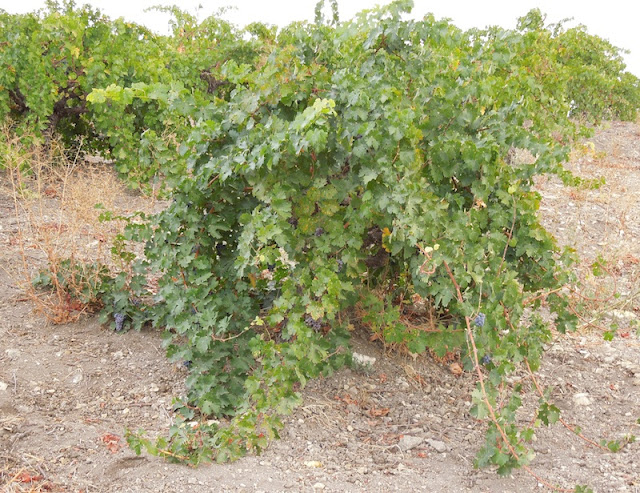Yarrow is an Ideal Xeriscaping Plant
Yesterday I wrote about
xeriscaping and showed you some examples. Although I didn't recognize yarrow in any of them, I wasn't able to go onto private property for a closer look. Still,
yarrow is ideal for xeriscaping because it is drought tolerant, spreads to fill available space, and adds color to the garden in season. What you see below is along the Charolais Corridor Trail in Paso Robles
 |
| Insects on Yellow Yarrow, © B. Radisavljevic |
Yarrow in Paso Robles Xeriscapes
If you are on the lookout for it, you will see a lot of yarrow in Paso Robles and the rest of the North County. Both the shot above and the one directly below were taken on the Charolais Corridor Trail between South River Road and Riverbank Lane, ending just across from an entrance to Larry Moore Park. The photo below was taken at the entrance to the trail on Riverbank Lane. On most of the trail, yarrow is mixed with cistus (the pink, purple flowers), rosemary, and cotoneaster. Between them, there is color in almost every season.
 |
| Xeriscaping with Yarrow, © B. Radisavljevic |
In autumn, the yarrow flowers dry well and can be used in dry flower arrangements. They are still adding interest even when dry along this trail and at Larry Moore Park, where, as I recall, they have also planted yarrow. I didn't have time to check today to see if it's still there.
 |
| Dried Yarrow on Trail, © B. Radisavljevic |
Another place I've noticed seeing yarrow in the city is on South Vine Street east to of the Marriott Hotel, in the landscaping of the recently built dental building with the solar panels on the roof. This photo was taken there.
 |
| Xeriscaping with Yarrow on South Vine, © B. Radisavljevic |
Insects Are Attracted to Yarrow
In the top photo taken along the trail, you saw at least one fly and another insect which may also be a type of fly. Below is another shot from the xeriscape at the dental building on South Vine. There you see a very content bee on the yellow yarrow.
 |
| Bee on Yellow Yarrow, © B. Radisavljevic |
Yarrow Comes in Many Colors
The most common color I see is the yellow, as in the photos above. Common yarrow (Achillea Millefolium) often grows wild with a white flower.
The Sunset Western Garden Problem Solver lists it as a weed because it grows wild and is often invasive. I haven't seen it growing wild and white yet. My own yarrow plant, which I currently have confined to a container, is red. It's called a grapefruit yarrow. It is just starting to bloom this week.
 |
| Grapefruit Yarrow, © B. Radisavljevic |
I've also seen beautiful yarrow plantings at some wineries. I honestly don't remember at which one I took the picture below. The yarrow appears to be next to some sage and lavender, judging just from their leaves.
 |
| Yarrow in Mixed Colors, © B. Radisavljevic |
Cultivation and Uses of Yarrow
Yarrow likes to grow in the sun. It needs some irrigation until it is established, but then it can usually get along with rain water. It likes a moderately rich, well-drained soil with a pH of 6.1. It is hardy to Zone 2. Yarrow can adapt to a variety of soils, as long as you don't let its feet get too wet.
Yarrow grows easily from seed, but I started with a nursery plant from a local organic grower. You can divide yarrow plants in spring and fall. I will probably divide mine and put some into a flower bed next fall.
According to
Rodale's Illustrated Encyclopedia of Herbs, people have used yarrow for over 60,000 years. Archaeologists discovered it in fossils in Neanderthal burial caves. Since then people have found many uses for it medicinally, and cosmetically. It has been used for crafts and to make dye. It is said that when planted near other herbs, it will increase the essential oils they produce. This has not been proved.
If you'd like to try growing yarrow, why not look through
Amazon's amazing variety of seed choices. I may even get some seed myself, just to try some new colors. Maybe I'll redo my lawn with yarrow, sage, lavender, euphorbia, and rosemary. I'll leave that decision for another day.
If you found this post useful, please share it. The sharing buttons are just above the comment box at the end of the post. The photo below is especially designed for pinning. The yarrow photos in the collage were all taken along the Charolais Corridor Trail.























































